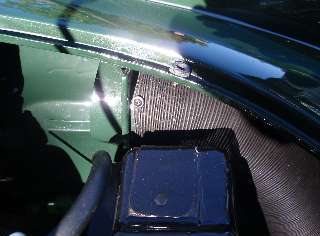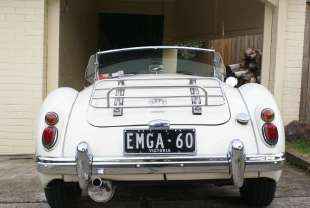The MGA With An Attitude
MGA assembly in Australia, Body Assembly - CKD-102B2
From Thomas Aczel in Australia:
 "The carburetor cool air duct hose is secured on Australian cars at it's rearmost end not by a clip, but by a screw, the same screw as secures the door trim".
"The carburetor cool air duct hose is secured on Australian cars at it's rearmost end not by a clip, but by a screw, the same screw as secures the door trim".
From Garry Kemm in Australia:
"On Australian assembled cars both the pedal excluder retainer plate and the corresponding blanking retainer plate were always installed upside down, that is the opposite to the UK. The blanking plate rubber gasket may or may not have been thicker".
Frank Henskens reports:
"I have also checked on the upside down blanking plate. On our cars they are installed with the curve downwards - the same as on the Mk II and the 1500 cars I previously owned".
For the pedal excluder and blanking plate, it seems that installing those upside down would require a special gasket, somewhat thicker than the flange height on the formed pates. I have not yet seen a picture of this or a description of the gasket (rubber blanking plate?) used in such cases. Use of the UK type pedal excluder and/or thin gasket with the plate upside down would likely result in distortion of the plate and leaks, and maybe chipped paint on the body. There are other reports of these plates either side up, and the "reporters" generally insist their style is original issue on their car. This point might be disputed indefinitely.
From Gary Kemm on 5/13/2010:
"The introduction of the later style shut panels occurred on UK cars at chassis 101292. There is no reason to believe that it was otherwise for Australian assembled CKD MGA Mk2's. The later style shut panels need the modified rear door seal finisher so the change point is easily established by reference to the Factory SPL page R32.
 "Build dates for chassis numbers sent to Australia can be quite different to what would be expected when referring to UK build dates. Firstly, because of the approx. 2 months sea voyage, as well as delays loading and unloading at the docks. As sales of the 1600 Mk1 slowed down significantly in 1961, BMC Australia delayed MGA assembly. For example, chassis 100051, which was dispatched from the UK on 13 Jan 1961 was not assembled in Australia till December 1961, and chassis 100301, dispatched 24 Feb 1961 from the UK was not assembled till Feb 1962. The first batch of Mk2's sent to Australia on 5 May 1961 were held back and not assembled till end Feb 1962, after all the Mk1's were eventually completed". "Build dates for chassis numbers sent to Australia can be quite different to what would be expected when referring to UK build dates. Firstly, because of the approx. 2 months sea voyage, as well as delays loading and unloading at the docks. As sales of the 1600 Mk1 slowed down significantly in 1961, BMC Australia delayed MGA assembly. For example, chassis 100051, which was dispatched from the UK on 13 Jan 1961 was not assembled in Australia till December 1961, and chassis 100301, dispatched 24 Feb 1961 from the UK was not assembled till Feb 1962. The first batch of Mk2's sent to Australia on 5 May 1961 were held back and not assembled till end Feb 1962, after all the Mk1's were eventually completed".
On 5/9/2010 -0600, Greg Keenan in Bradbury NSW Australia (MGA Registrar Sydney Australia) wrote:
"A few years ago I restored an early Australian built 1600 Mk2, chassis number 100441. This car was fitted with the early type shut panels. Although I received the body shell from the owner in pieces as he had pulled it apart I could tell the shut panels were the original panels. On Australian built cars they lead wiped the top of the rear guard where it met the door. This was done after the shut panel was fitted so the lead was wiped over edge of the guard and on to the shut panel. All the original lead was still in place on this car".
From Frank Henskens: , January 2010
" Another difference for Australian cars is that the door sill is welded at the front rather than riveted".
Addendum, May 2010:
Catching up with more reported differences. Since the AU car bodies were assembled and welded using a standard car frame for the alignment jig, the lower flange of the rocker panel was either hand welded or riveted in place rather than spot welded. That idea has me curious about how the inner box panel of the body sill may have been welded, as none of the edge flanges of that panel would be accessible for spot welding while sitting on the frame. The AU rocker panels were also welded at the front and rear top flanges rather than riveted. (Curiously, I have seen a few recent reports of some AU produced cars with the bottom edge of the rocker panel secured with pop rivets rather then spot welding, commonly 2 or 3 but in some cases up to 5 rivets).
 Apparently all AU produced MGA had no hole in the rear valance panel for passage of the license lamp wire. This wire was run under the bottom edge of the panel, then up the outside surface where is was visible below the rear bumper. AU produced 1600-MK-II models had painted dash, no vinyl cover on the dash or scuttle area aft of the windscreen like the UL cars, but they did have the bright trim along the bottom of the dash panel and also the chrome bezel over the speaker and horn button in center of the dash.
Apparently all AU produced MGA had no hole in the rear valance panel for passage of the license lamp wire. This wire was run under the bottom edge of the panel, then up the outside surface where is was visible below the rear bumper. AU produced 1600-MK-II models had painted dash, no vinyl cover on the dash or scuttle area aft of the windscreen like the UL cars, but they did have the bright trim along the bottom of the dash panel and also the chrome bezel over the speaker and horn button in center of the dash.
|